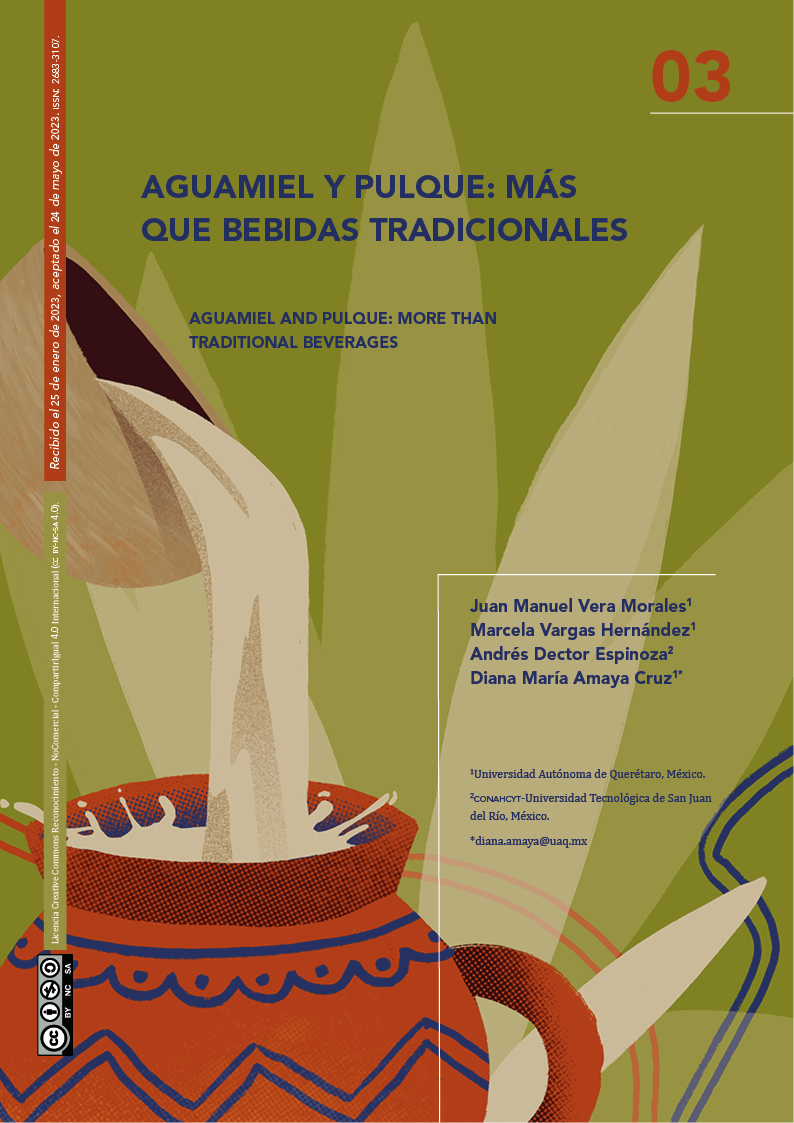Abstract
El aguamiel y el pulque hacen parte de la herencia no solo gastronómica, sino cultural y religiosa de México por todo lo que rodea su siembra, cosecha, recolecta, fermentación y consumo. El pulque es la bebida tradicional fermentada más importante en la zona central del país y a pesar de la drástica disminución que se está dando en su consumo; los consumidores tienen un claro interés en bebidas tradiciones fermentadas como tepache, pulque, tejuino, etc.; debido a las tendencias del mercado y a los beneficios conocidos para la salud; algunos ya reportados y otros en los que es necesario generar evidencias científicas de calidad, pues hay muchas creencias alrededor de su consumo. Esto representa una luz de esperanza para el rescate de estas bebidas, que incluso ya son reconocidas como funcionales al tener características nutricionales bien documentadas, y sobre todo su potencial como fuente de prebióticos y probióticos que pueden modular la microbiota intestinal de quien lo consume. En este trabajo se revisaron algunas generalidades y los efectos prebióticos, probióticos; y las perspectivas de uso del pulque y el aguamiel.
References
M. L. Cázares-Vásquez et al., “Microbial exopolysaccharides in traditional mexican fermented beverages,” Fermentation, vol. 7, no. 4. 2021, doi: 10.3390/fermentation7040249.
S. L. Villarreal-Morales et al., “7 - Aguamiel a fresh beverage from agave spp. sap with functional properties,” A. M. Grumezescu and A. M. B. T.-N. B. Holban, Eds. Academic Press, 2019, pp. 179–208.
R. I. Ortiz-Basurto, G. Pourcelly, T. Doco, P. Williams, M. Dornier, and M.-P. Belleville, “Analysis of the Main Components of the Aguamiel Produced by the Maguey-Pulquero (Agave mapisaga) throughout the Harvest Period,” J. Agric. Food Chem., vol. 56, no. 10, pp. 3682–3687, May 2008, doi: 10.1021/jf072767h.
M. R. Romero-López, P. Osorio-Díaz, A. Flores-Morales, R. Mora-Escobedo, and N. Robledo, “Chemical composition, antioxidant capacity and prebiotic effect of aguamiel (Agave atrovirens) during in vitro fermentation,” Rev. Mex. Ing. Química, vol. 14, no. 2, pp. 281–292, 2015.
G. D. Álvarez-Ríos, C. J. Figueredo-Urbina, and A. Casas, “Physical, chemical, and microbiological characteristics of pulque: management of a fermented beverage in Michoacán, Mexico,” Foods, vol. 9, no. 3. 2020, doi: 10.3390/foods9030361.
A. Escalante, D. R. López Soto, J. E. Velázquez Gutiérrez, M. Giles-Gómez, F. Bolívar, and A. López-Munguía, “Pulque, a traditional mexican alcoholic fermented beverage: historical, microbiological, and technical aspects,” Front. Microbiol., vol. 7, 2016, doi: 10.3389/fmicb.2016.01026.
A. Escalante, M. Elena Rodríguez, A. Martínez, A. López-Munguía, F. Bolívar, and G. Gosset, “Characterization of bacterial diversity in Pulque, a traditional Mexican alcoholic fermented beverage, as determined by 16S rDNA analysis,” FEMS Microbiol. Lett., vol. 235, no. 2, pp. 273–279, Jun. 2004, doi: 10.1111/j.1574-6968.2004.tb09599.x.
A. Cervantes-Elizarrarás et al., “In vitro probiotic potential of lactic acid bacteria isolated from aguamiel and pulque and antibacterial activity against pathogens,” Applied Sciences, vol. 9, no. 3. 2019, doi: 10.3390/app9030601.
G. D. Álvarez-Ríos, A. Casas, L. Pérez-Volkow, C. J. Figueredo-Urbina, J. de Dios Páramo-Gómez, and M. Vallejo, “Pulque and pulquerías of Mexico City: a traditional fermented beverage and spaces of biocultural conservation,” J. Ethn. Foods, vol. 9, no. 1, p. 40, 2022, doi: 10.1186/s42779-022-00155-2.
D. Muñiz-Márquez, R. Rodríguez-Jasso, R. Rodríguez-Herrera, J. ContrerasEsquivel, and C. Aguilar-González, “Producción artesanal del aguamiel: una bebida tradicional mexicana,” Rev. Científica la Univ. Autónoma Coahuila, vol. 5, no. 10, pp. 12–19, 2013.
C. O. Carranza, A. Á. Fernandez, G. R. Bustillo Armendáriz, and A. López-Munguía, “Chapter 15 - Processing of fructans and oligosaccharides from Agave plants,” V. B. T.-P. and I. on A. C. in F. Preedy, Ed. San Diego: Academic Press, 2015, pp. 121–129.
D. B. Muñiz-Márquez, J. A. Teixeira, S. I. Mussatto, J. C. Contreras-Esquivel, R. Rodríguez-Herrera, and C. N. Aguilar, “Fructo-oligosaccharides (FOS) production by fungal submerged culture using aguamiel as a low-cost by-product,” LWT, vol. 102, pp. 75–79, 2019, doi: https://doi.org/10.1016/j.lwt.2018.12.020.
G. J. Gerwig, “Structural Analysis of Exopolysaccharides from Lactic Acid Bacteria.,” Methods Mol. Biol., vol. 1887, pp. 67–84, 2019, doi: 10.1007/978-1-4939-8907-2_7.
W.-H. Min, X.-B. Fang, T. Wu, L. Fang, C.-L. Liu, and J. Wang, “Characterization and antioxidant activity of an acidic exopolysaccharide from Lactobacillus plantarum JLAU103.,” J. Biosci. Bioeng., vol. 127, no. 6, pp. 758–766, Jun. 2019, doi: 10.1016/j.jbiosc.2018.12.004.
N. H. Maina, M. Tenkanen, H. Maaheimo, R. Juvonen, and L. Virkki, “NMR spectroscopic analysis of exopolysaccharides produced by Leuconostoc citreum and Weissella confusa.,” Carbohydr. Res., vol. 343, no. 9, pp. 1446–1455, Jul. 2008, doi: 10.1016/j.carres.2008.04.012.
E. Torres-Maravilla et al., “Identification of novel anti-inflammatory probiotic strains isolated from pulque,” Appl. Microbiol. Biotechnol., vol. 100, no. 1, pp. 385–396, 2016, doi: 10.1007/s00253-015-7049-4.
L. Márquez-Morales, E. G. El-Kassis, J. Cavazos-Arroyo, V. Rocha-Rocha, F. Martínez-Gutiérrez, and B. Pérez-Armendáriz, “Effect of the intake of a traditional mexican beverage fermented with lactic acid bacteria on academic stress in medical students,” Nutrients, vol. 13, no. 5. 2021, doi: 10.3390/nu13051551.
E. Rojas-Rivas, F. C. Viesca-González, H. J. Favila-Cisneros, and F. Cuffia, “Consumers’ perception of a traditional fermented beverage in Central Mexico,” Br. Food J., vol. 122, no. 2, pp. 708–721, Jan. 2020, doi: 10.1108/BFJ-05-2019-0317.
A. E. Alcántara-Zavala and J. de Dios Figueroa-Cárdenas, “Shelf life, physicochemical and antioxidant properties of red cactus pear pulque processed by ohmic heating and by conventional pasteurization,” Int. J. Gastron. Food Sci., vol. 28, p. 100497, 2022, doi: https://doi.org/10.1016/j.ijgfs.2022.100497.

This work is licensed under a Creative Commons Attribution-NonCommercial-ShareAlike 4.0 International License.
Copyright (c) 2024 Perspectivas de la Ciencia y la Tecnología

